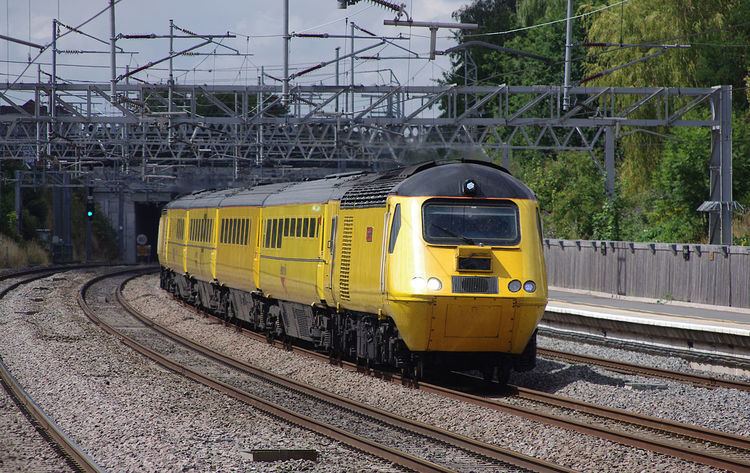In service 2003 - present Number built 1 trainset | Family name HST | |
 | ||
The New Measurement Train (NMT), is a specialised train which operates in the United Kingdom to assess the condition of track so that engineers can determine where to work. It is a specially converted High Speed Train, consisting of two Class 43 power cars and five Mark 3 carriages. It can check the condition of most main lines and some secondary routes operating a 13-week rolling cycle. The train is permitted to travel across any part of the network where HSTs are permitted, as well as High Speed 1.
Contents
History
The NMT was formed in direct response to concern over gauge corner cracking following the October 2000 Hatfield rail crash. In September 2002 work commenced on preparing ex Virgin CrossCountry Class 43 power cars 43013, 43014 and 43062 and two Mark 2 and three Mark 3 carriages from the Railway Technical Centre fleet. Only two carriages carried testing equipment, the extra carriages being required for brake force purposes. The NMT entered service on 9 May 2003. The two Mark 2s were replaced in 2004 with ex Virgin CrossCountry Mark 3s. In August 2005 a further Mark 3 joined the fleet fitted with a pantograph.
In 2004/05, power cars 43067, 43154 and 43196 were added while the core fleet was upgraded. All had been placed in store by February 2006.
In 2009/10, 43013, 43014 and 43062 had their Paxman Valenta engines replaced with MTU engines by Brush Traction.
Operation
The train measures the contact between rails, wheels and the overhead electric supply line. Lasers and other instruments are used to make other measurements of the track geometry and other features such as overhead line height and stagger, and the track gauge, twist and cant. On the West Coast Main Line, particular care has to be taken to ensure that clearances are maintained for the use of tilting trains. The train captures video footage from the front and rear power cars, and video of the pantograph and wheel interfaces.
The Development Vehicle (DV) includes a video based system utilising image recognition systems to look for defects such as missing clips. The vehicle also houses both a contact and non-contact Over-Head Line monitoring system used to detect faults in overhead wires. White lights next to the pantograph project a line followed by cameras to enable the height, stagger and wear of the contact wire to be monitored. The wear on the contact wire is measured as the width of a strip on the underside, where the pantographs of trains come into contact and wear away the cable. If the original thickness of the cable is known, this can be converted into a percentage of remaining area, which in turn when related to a maximum allowable wear can give an estimate of the remaining life left. No traction or system power is drawn using the pantograph, as the train is diesel powered.
The track recording systems vehicle has banks of screens allowing the team of three operators to view a range of system outputs, including track faults, train location, and radio signal strength.
One of the Messing Cars hosts a system for monitoring and commissioning of Network Rail's various radio systems (GSM-R, CSR and NRN).
It is allocated to Heaton TMD in Newcastle-upon-Tyne, returning there for scheduled maintenance every Sunday. Maintenance of the recording equipment is carried out at the Railway Technical Centre in Derby.
Models
Hornby released a train pack of the two HST power cars which can be easily obtained on the website. Hornby also released an ex TF and an ex TGS Mk 3 coaches to go with the two power cars.
